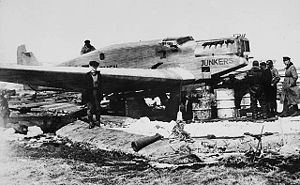
Back Junkers W 33 German Junkers W 33 Spanish یونکرس و ۳۳ Persian Junkers W 33 French Junkers W 33 Italian Junkers W 33 NB Junkers W 33 Polish Junkers W 33 Portuguese Junkers W 33 Russian Junkers W 33 Swedish
| W 33 | |
|---|---|

| |
| W 33 Bremen after its historic Atlantic crossing. | |
| Role | Transport |
| Manufacturer | Junkers |
| Designer | Herman Pohlmann[1] |
| First flight | 17 June 1926[2] |
| Introduction | 1927 |
| Status | retired |
| Produced | 1927–34 |
| Number built | 199 |
| Variants | Junkers W 34 Junkers Ju 46 |
The Junkers W 33 was a German 1920s single-engine low-wing monoplane transport aircraft that followed Junkers standard practice making extensive use of corrugated aluminium alloy over an aluminium alloy tube frame, that was developed from the similar but slightly smaller Junkers F 13, and evolved into the similar W 34. One example, named Bremen, was the first aircraft to complete the much more difficult east–west non-stop heavier-than-air crossing of the Atlantic.
- ^ Zoeller, Horst. "Junkers – Who is Who?". The Hugo Junkers Homepage. Archived from the original on October 27, 2009. Retrieved 2016-06-22.
{{cite web}}: CS1 maint: unfit URL (link) - ^ Kay, 2004, p. 64
© MMXXIII Rich X Search. We shall prevail. All rights reserved. Rich X Search